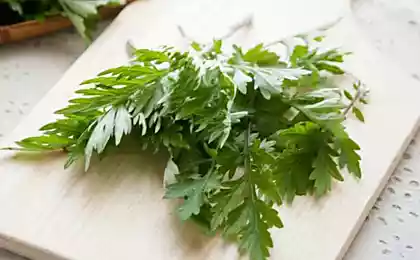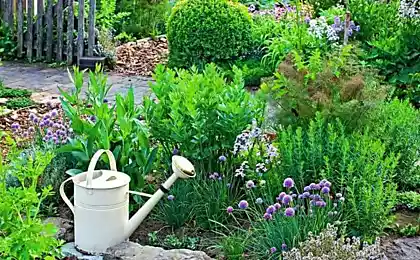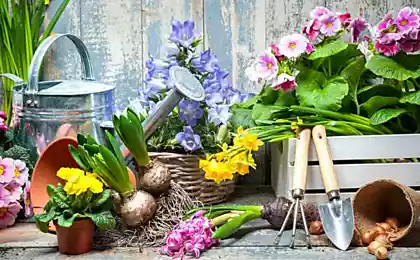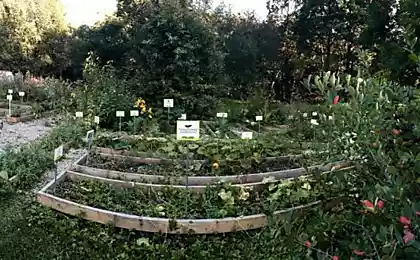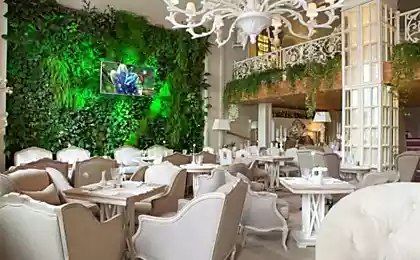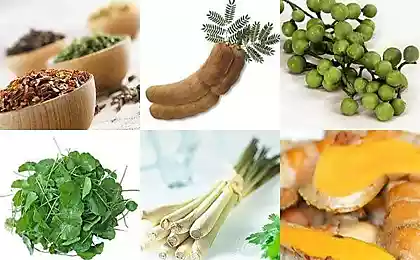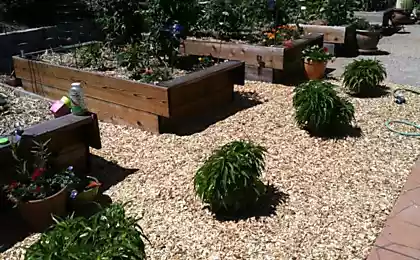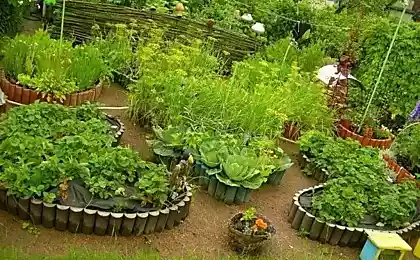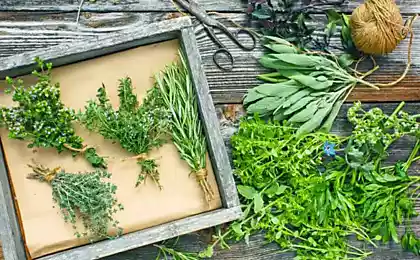468
How and what plants to create a spicy garden
Spicy herbs are plants containing overhead and/or underground parts of biologically active substances and essential oils, stimulating the taste buds, causing the appetite and improve digestive activity. Their use in food can dramatically change the perception of familiar dishes. In addition to flavor and taste, they usually have medicinal properties.

Classification of herbal plants taste and aroma
Herbs are divided into taste (horseradish, lovage, cumin, etc.) and aromatic (oregano, dill, marjoram, etc.). More detailed division can look like the following:

Kitchen English garden
The British we can safely give the palm for the introduction of herbs in horticultural practice. They have long colonized India, and after returning home longed for the fragrant food, and therefore began to grow favorite plants. Later arose the concept of "kitchen" an English garden, implying a small garden located near the house where separate groups were planted herbs. Such plantings are well read the taste preferences of the hostess. In addition, spice stands are the perfect decoration for the local area.
Not many people are well versed in the tastes and aromas of spice plants, most known only parsley, dill, cilantro, garlic and onions. So once you grow a plant or buy, to smell and taste it, to know exactly you need it or not.
Among the spice plants are perennials (peppermint, thyme, sage, etc.) and annuals (Basil, chervil, mustard leaf, etc.), tall (lovage, tarragon, oregano, etc.) and groundcover (thyme, hyssop, etc.). Resident perennials able to grow long in one place, it is advisable to decide immediately.
To give a spicy brightness to the garden you can plant red quinoa, mustard with red leaves, Borago (borage) with blue flowers, etc. do Not be redundant and familiar floral plants such as calendula and nasturtium. Look spectacular strawberry spinach, and various years of Luke (slizun, chives), especially in the flowering period.
Under the plant for teas and fragrances, it is desirable to allocate a separate place. In the Central part it is possible to plant bergenia or monarda lemon. Mint, Catnip and lemon balm better prikopat in pots. Great jewelry this landing may be a Moldavian dragonhead.
How to arrange group planting
Location of plants in a group planting depends on, or there is no opportunity to look at them from different angles. If spicy garden will be viewed from all angles, tall specimens should be placed in the center. Next to them plant tall biennials (parsnip, caraway, etc.) and annuals (chervil, fennel, dill stem, etc.). In the foreground on the Sunny side should be small annual herbs (curly parsley, Basil, dragonhead, mustard leaf, mizuna (Japanese cabbage), etc.). More interesting they look when planted in small clumps of irregular shape.
Of herbs, you can create interesting compositions
In the case where the spicy garden is not visible from one side, for example, is located near the fence, the placement of plants is slightly different. Tall should be in the background, and undersized in the front, with the gap given average height.
Some annual herbs (mustard, chervil, dill leaf, etc.) can be sown twice and even three times per season, so they should be left free sites in the spicy garden.
Tall plants at back, short — front
Features planting some perennials spicy spicy heat-loving perennials (rosemary, oregano, marjoram, chili, etc.) shouldn't just be planted in the ground, because at low temperatures they will die. In order not to lose their favorite plants, they can be prikopat in the soil directly with pots, and with the cold back into the house.
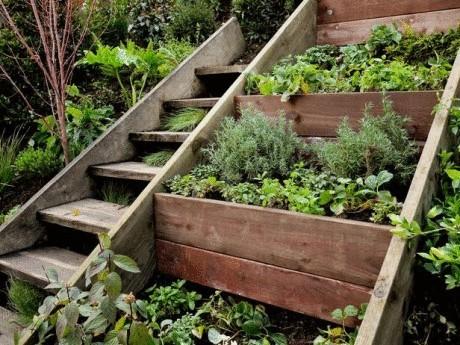
Heat-loving perennials dropwise in the beds directly in pots
Particularly aggressive plants (horseradish, mint etc.) it is desirable to limit in space, otherwise they will displace neighbors. For this soil dig in bucket without a bottom, or install a small sheet of slate, and only after conducting a landing.
Other places and the benefits from planting If there is no possibility to create a spicy garden, you can find other options. Some perennials (mint, rhubarb, tarragon, marjoram, lovage) grow well between fruit trees. Melliferous herbs (thyme, calendula, hyssop, marigolds, dragonhead, nasturtium) will fit well in flower gardens. Chervil and Basil are the perfect complement to planting tomatoes and peppers in greenhouses, contribute to their pollination.
Some herbs can be planted between trees and under them
Herbs besides the main purpose can be used to protect vegetable crops from pests. Potatoes and beets saves the coriander and cucumber, onion and tomato — Basil. From caterpillars, aphids and bean fly guard lavender, thyme, savory, hyssop and sage. Healing effect on the soil have nasturtium, garlic, coriander, savory, dill, anise, mint, borage (Borago), onion, purslane, coriander.
Interesting options for garden beds or some magic Planting spicy plants at the site in the form of a cross, borrowed from the crusaders, reflects the Christian symbolism. It is believed that it protects from dark powers and gives the plants additional magical properties. From the crusaders entered the culture to plant herbs close to large stones. The day the stones are heated from the sun, and in the evening give off heat to the plants, increasing the allocation of aromatic substances. In such circumstances, the entire surrounding area is filled with fragrance.
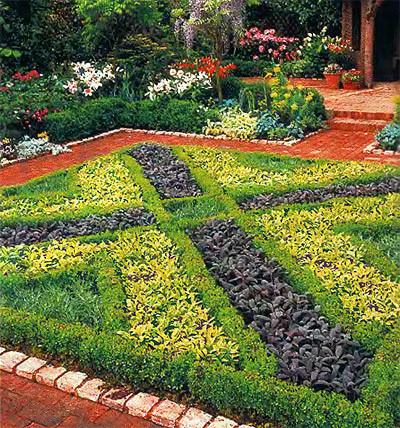
This spicy fit can serve as a talisman of the house
Spiral garden came from the druids. This is an interesting element of landscape design, symbolizing the cosmic spiral and the sun. It is believed that such plantings represent a particular field, stimulating the growth of plants. Interestingly, diseases and pests plants on the spiral ridge is almost not affected, and vegetative mass building up quicker.
Spiral for the garden plants is practically not affected by diseases and pests. published
P. S. And remember, only by changing their consumption — together we change the world! ©
Source: 101dizain.ru

Classification of herbal plants taste and aroma
Herbs are divided into taste (horseradish, lovage, cumin, etc.) and aromatic (oregano, dill, marjoram, etc.). More detailed division can look like the following:
- bitter-sharp taste, but with a weak flavor (horseradish, mustard, spiny dogfish, etc.);
- bitter with a pungent smell (Bay leaf, lovage, rosemary, Angelica, etc.);
- strong with a sweet, but mild and unobtrusive flavor, specific taste (cilantro, lofant anise, hyssop, Basil, etc.);
- with subtle spicy flavor (tarragon, arugula, marjoram, savory, cumin, etc.);
- with characteristic individual properties (leek, sage, garlic, mint, onion, etc.)
- for drinks and making perfume dishes (mint, bee balm, cephalophora, saxifrage, etc.).

Kitchen English garden
The British we can safely give the palm for the introduction of herbs in horticultural practice. They have long colonized India, and after returning home longed for the fragrant food, and therefore began to grow favorite plants. Later arose the concept of "kitchen" an English garden, implying a small garden located near the house where separate groups were planted herbs. Such plantings are well read the taste preferences of the hostess. In addition, spice stands are the perfect decoration for the local area.
Not many people are well versed in the tastes and aromas of spice plants, most known only parsley, dill, cilantro, garlic and onions. So once you grow a plant or buy, to smell and taste it, to know exactly you need it or not.
Among the spice plants are perennials (peppermint, thyme, sage, etc.) and annuals (Basil, chervil, mustard leaf, etc.), tall (lovage, tarragon, oregano, etc.) and groundcover (thyme, hyssop, etc.). Resident perennials able to grow long in one place, it is advisable to decide immediately.
To give a spicy brightness to the garden you can plant red quinoa, mustard with red leaves, Borago (borage) with blue flowers, etc. do Not be redundant and familiar floral plants such as calendula and nasturtium. Look spectacular strawberry spinach, and various years of Luke (slizun, chives), especially in the flowering period.
Under the plant for teas and fragrances, it is desirable to allocate a separate place. In the Central part it is possible to plant bergenia or monarda lemon. Mint, Catnip and lemon balm better prikopat in pots. Great jewelry this landing may be a Moldavian dragonhead.
How to arrange group planting
Location of plants in a group planting depends on, or there is no opportunity to look at them from different angles. If spicy garden will be viewed from all angles, tall specimens should be placed in the center. Next to them plant tall biennials (parsnip, caraway, etc.) and annuals (chervil, fennel, dill stem, etc.). In the foreground on the Sunny side should be small annual herbs (curly parsley, Basil, dragonhead, mustard leaf, mizuna (Japanese cabbage), etc.). More interesting they look when planted in small clumps of irregular shape.
Of herbs, you can create interesting compositions
In the case where the spicy garden is not visible from one side, for example, is located near the fence, the placement of plants is slightly different. Tall should be in the background, and undersized in the front, with the gap given average height.
Some annual herbs (mustard, chervil, dill leaf, etc.) can be sown twice and even three times per season, so they should be left free sites in the spicy garden.
Tall plants at back, short — front
Features planting some perennials spicy spicy heat-loving perennials (rosemary, oregano, marjoram, chili, etc.) shouldn't just be planted in the ground, because at low temperatures they will die. In order not to lose their favorite plants, they can be prikopat in the soil directly with pots, and with the cold back into the house.

Heat-loving perennials dropwise in the beds directly in pots
Particularly aggressive plants (horseradish, mint etc.) it is desirable to limit in space, otherwise they will displace neighbors. For this soil dig in bucket without a bottom, or install a small sheet of slate, and only after conducting a landing.
Other places and the benefits from planting If there is no possibility to create a spicy garden, you can find other options. Some perennials (mint, rhubarb, tarragon, marjoram, lovage) grow well between fruit trees. Melliferous herbs (thyme, calendula, hyssop, marigolds, dragonhead, nasturtium) will fit well in flower gardens. Chervil and Basil are the perfect complement to planting tomatoes and peppers in greenhouses, contribute to their pollination.
Some herbs can be planted between trees and under them
Herbs besides the main purpose can be used to protect vegetable crops from pests. Potatoes and beets saves the coriander and cucumber, onion and tomato — Basil. From caterpillars, aphids and bean fly guard lavender, thyme, savory, hyssop and sage. Healing effect on the soil have nasturtium, garlic, coriander, savory, dill, anise, mint, borage (Borago), onion, purslane, coriander.
Interesting options for garden beds or some magic Planting spicy plants at the site in the form of a cross, borrowed from the crusaders, reflects the Christian symbolism. It is believed that it protects from dark powers and gives the plants additional magical properties. From the crusaders entered the culture to plant herbs close to large stones. The day the stones are heated from the sun, and in the evening give off heat to the plants, increasing the allocation of aromatic substances. In such circumstances, the entire surrounding area is filled with fragrance.

This spicy fit can serve as a talisman of the house
Spiral garden came from the druids. This is an interesting element of landscape design, symbolizing the cosmic spiral and the sun. It is believed that such plantings represent a particular field, stimulating the growth of plants. Interestingly, diseases and pests plants on the spiral ridge is almost not affected, and vegetative mass building up quicker.
Spiral for the garden plants is practically not affected by diseases and pests. published
P. S. And remember, only by changing their consumption — together we change the world! ©
Source: 101dizain.ru

